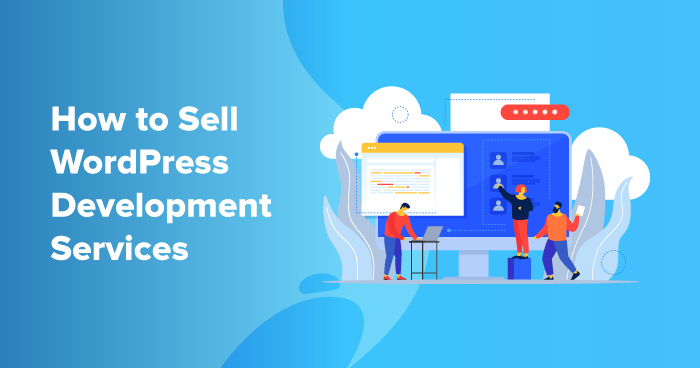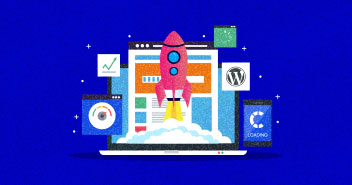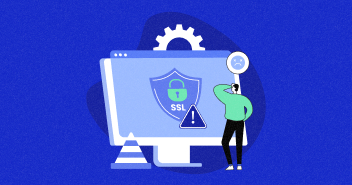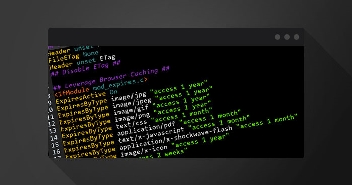
It’s maddening, tiring, and at times, immensely rewarding. I’m, of course, talking about to sell WordPress development services.
As a WordPress development company, you have your work cut out for you. You have to attract leads, convert them into clients, develop their projects, maybe even pitch them a recurring reseller hosting plan and make sure that they’re happy.
And if that wasn’t enough, you also have to juggle dozens of projects while attracting talented employees.
How can you bring order to this madness? What can you do to organize your operations for maximum efficiency? Are there any frameworks you can use to sell WordPress development services easier?
I’ll answer all these questions, and more, in this detailed guide.
1. Organizing Your Operations
A shared characteristic of every overwhelmed agency I’ve worked with is how little structure they have to their operations. They often have developers moonlighting as client service reps, marketers burdened with sales and managers who double up as recruiters.
This is largely due to the nature of the development services itself. Few agencies are set up as deliberate businesses. Rather, they often go from freelance practice to boutique shops, and from boutique shops to medium-sized agencies.
This haphazard and often rapid growth gives you little room to set up formal organizational structures. The result? Chaos, confusion, and a general feeling of “drowning” in your work.
So step one: understand, then organize your operations.
WordPress development services companies, like agencies, essentially have three core divisions:
- Accounts: All the services associated with acquiring, managing, and retaining clients. This includes both “outside” roles such as sales and internally-oriented roles such as project/account managers.
- Development/creative: All the services associated with servicing client needs. This includes roles as varied as design, development, copywriting, etc. If you sell it as a service, it would fall under this umbrella.
- Support: This includes every role that facilitates the above two, such as HR, accounting, legal, etc. While not necessary for operations, a well-organized support department is crucial for scaling your agency.
A common way to organize agency operations is to segregate them into broad ‘Account’ and ‘Creative’ departments. An executive layer of senior leaders – CEOs and VPs – sits on top of them, defining strategy.
Ancillary departments – legal, HR, etc. – offer support to the Accounts and Creative people.

In large agencies that offer a range of services, it’s not unusual to organize operations by service. Thus, you might have separate “Public Relations” and “Design” departments with their own accounts and creative people.
WordPress development services, of course, are different. For one, you usually have only one area of focus – WordPress. You might also not have enough clients or employees to warrant multiple layers of management.
So before deciding your organizational structure, consider the following:
- Services offered: How you organize your agency will depend on the kind of services you offer, and how much they contribute to your revenues. If development makes up 90% of your revenues, it makes sense to organize your agency around developers. But if there is a 60-40 revenue split between development and design, you’ll want separate departments. Also if you resell hosting rather than having a set up of dedicated servers then you will need fewer people for web hosting management of clients.
- Number of clients: The higher this figure, the more managerial oversight you need. A typical rule of the thumb is that an AE (Account Executive) can manage between 5-7 times his/her annual pay. Thus, an AE with a salary of $50k can manage between $250-350k in annual billings.
- Average deal-size: Larger clients require a higher level of service than smaller accounts. On deals worth over $100k, you’ll even want multiple levels of account executives. Larger deals also need more high-touch sales tactics, which will shoot up your employee count.
- Number of employees: According to Deloitte, the average manager in a US company has 7 direct reports. In other words, a single manager can handle around 9-11 employees. This will change based on how experienced your employees are, but you can take this as a ballpark figure.
- Agency size and growth trajectory: In smaller agencies, senior executives and managers can manage recruitment and HR, while legal and accounting can be outsourced. But if you find yourself overwhelmed by these functions, or you predict explosive growth in the near future, consider hiring dedicated people for these roles.
- Sales focus: Agencies that sell highly customized, boutique solutions don’t always benefit from dedicated sales teams. However, if your solutions can be commoditized, you might find that setting up a separate business development department can bring in accelerated results.
The complexity of your organizational structure will depend a lot on your answers to the above questions.
One way to structure your agency is to revolve it around account or project managers. As the bridge between clients and project teams, account managers can “connect” your organization together.
A project manager-focused agency structure would look this way:

In this structure, the account manager(s) act as the organization’s “home base”. Besides managing actual projects, they also:
- Guide business development teams on what kind of clients to pursue.
- Interface with account executives for smoother client relationships. Or in the absence of AEs, handle these relationships themselves.
- Collect and relay all information to senior leaders and executive teams.
Think of Pete Campbell or Roger Sterling from Mad Men – people who worked around and across departments, winning deals, keeping clients happy, and ensuring that everything stays on track.

— Source: Giphy
2. Map Your Client Flow
If you want to bring some method to your operational madness, you need answers to three questions:
- How do you acquire leads and turn them into clients?
- How do you serve clients after acquiring them?
- How do you debrief clients post-project-finish?
If you can answer these questions, you’ll essentially have a “map” of your client flow. This map will show the entire path a client takes from prospect to client to potential lead source (as a referrer).
Mapping this path will also help you create templates, processes, and automation rules to make things more efficient.
For instance, instead of creating a project proposal from scratch each time, you can:
- Understand different client types and their acquisition channels
- Create proposal templates for individual channels or client types
One agency I helped eventually built-up a small library of project proposal templates, organized as follows:

All these templates shared the same structural details, except for a couple of paragraphs identifying the lead type and lead source. This way, when a new lead entered the funnel, the agency could send the right proposal in minutes instead of hours.
Given that responding to leads within an hour generates 7x more conversions, setting up such systems can be crucial for scaling your agency.
The question now is: how do you map your entire client flow?
Start by segregating the entire client flow into multiple phases as follows:
Phase I: Pre-Lead
This is the phase before the client enters your funnel and becomes a lead. In this phase, you don’t know the client, nor does the client know you.
Your goal is to figure out where the client hangs out, what his key problems are, and how WordPress can help him solve them. With this information, you can create a strategy to turn this “prospect” into a “lead”.
The end result of this exercise should be a detailed buyer persona. Arsalan wrote a great guide on crafting a persona last year.
Phase II: Lead Acquisition
This phase defines that all-important step where the client enters your sales funnel. If you’ve done your homework above, you should have a clear strategy to map your acquisition process.
List all your current lead acquisition strategies, including the following:
- SEO plan, including target keywords, existing content, and link building tactics
- Paid media plan, including AdWords and Facebook PPC, sponsorships, etc.
- Earned media plan, such as PR, content marketing, etc.
- Landing pages, content upgrades, etc. used to capture leads
Phase III: Lead Conversion
Capturing leads is easy enough; turning them into clients is a whole different deal.
In this next phase, your goal is to define the processes you use to convert captured leads. This should include details of the following:
- Lead nurturing tactics, including drip email campaigns, marketing automation, etc.
- Lead scoring process, especially the criteria for conversion from lead to MQL (marketing qualified lead) to SQL (sales qualified lead)
- Sales process, including sales collateral, scripts, etc.
- Templates for closing deals such as project proposals, contracts, etc.
Phase IV: Client onboarding
Congratulations – you just captured a client? But what happens next? How do you cue in clients on what to expect next?
In the next phase, your goal is to map the processes you use to ensure that the client has a smooth landing. List the following:
- Any “welcome” emails you send to new clients
- Your process for gathering requirements and essential data (logins, passwords, etc.)
- How you decide which project manager (if you have more than one) gets to handle which clients
- Communication protocols, including client communication plans, support emails/phone numbers, etc.
Phase V: Project Execution and Delivery
The meat and potatoes of any WordPress development services providers are delivering the project. Clients don’t get to see this phase a lot, except for signing off on deliverables. But mapping it internally can reveal huge inefficiencies.
List the following:
- Your project management methodologies or frameworks
- Internal communication protocols, file-sharing systems, etc.
- Project planning, budget tracking, task tracking.
- Dealing with resources, including scheduling their work, delegating tasks, and ensuring there are no technical errors (such as task dependencies)
- Guides for technical processes such as setting up websites, adding commits to Github, structuring code, etc.
Phase VI: Post-Project Delivery
The final phase focuses on what happens after you wrap up the project. Agencies often forget this but if you want happy, recurring clients and referrals, it is crucial to map the post-delivery process as well.
List the following:
- Your process for debriefing your team and conducting a post-project performance analysis
- Your process – if any – for understanding the client’s satisfaction with the project (such as a Net Promoter Survey)
- Your approach to getting referrals from the client
Visually, you can map the entire journey as follows:

I know this sounds like a lot, but if you want to be a more mature development shop, mapping all these processes is crucial. The more formal structure you can bring to your work, the easier it will be for you to scale your operations.
3. Bring Order to Sales
By far, the biggest problem for small WordPress development agencies is sales. Far too many developers I know rely on tactics that are one-off, unsustainable, or plain inefficient to capture and convert leads.
But it doesn’t have to be that way. Sales can be systemized and scaled – it just takes some time to build the processes for it.
Your goal should be to create an “engine” that automatically captures and qualifies leads. Raw leads flow into this system and emerge as “qualified leads”.

First, a few terminologies:
- A lead is anyone whose information – email, name, phone number, etc. – you’ve captured
- A marketing qualified lead is anyone who responds to your initial nurturing offers
- A sales qualified lead is anyone who meets your minimum BANT criteria (more on this below)
- A sales accepted lead or opportunity is anyone that’s ready to be pushed to your sales team
These aren’t always applicable to WordPress development agencies, but if you’re selling a commoditized service as opposed to boutique development, adopting these sales principles can be great for scaling.
Capturing Leads
Capturing leads might be the easiest – or the hardest – part of the sales process. It all depends on your audience, budget, and experience with different lead generation strategies.
I won’t go into this part of sales in detail; the Cloudways blog already has plenty of resources for it. Check out these articles for a start:
- ‘The Leads Game’ eBook
- Best Practices for Social Media Lead Generation
- How to get clients for your agency?
Capturing Interest
A common mistake I see WordPress agencies making is conflating lead acquisition with lead interest.
The truth is that the majority of people who download your eBooks or fill your forms have no real interest in buying your services. Your first step, therefore, should be to eliminate all these low-interest leads.
How? By capturing “interest signals”.
For example, once you capture a lead, you can send them a series of articles on custom WordPress development. Reading each of these articles would count as a “signal” of interest.
After all, if a lead wasn’t interested in custom WordPress solutions, why would they read a technical article in the first place?
Since your goal is to capture interest, the article series should answer the fundamental questions about your agency, such as:
- What is custom WordPress development
- How it can benefit small businesses (or any of your other target market)
- Why you should choose a custom WordPress development partner (case studies)
A lead that reads all the three articles in the series should be marked as “high interest”. Move it to a separate funnel for BANT qualification.
BANT Qualification
BANT is one of the most popular criteria for qualifying a lead. As per these criteria, a lead is “sales qualified” if it meets the following four factors:

How you capture this BANT information will vary a lot. You can:
- Capture information directly by offering content in exchange for information. For instance, you might have the following structure:
- The first offer: Ask for name and email
- The Second offer: Ask for company name and designation
- The fourth offer: Ask for budget
- Use lead intelligence tools such as Data.com, LeadIQ, Datanyze, etc.
- Call leads and ask for this information directly
- Manual research via LinkedIn
A “high interest” lead that also meets your BANT criteria (which will be different from business to business) is ready to be sent to your salespeople.
You don’t have to do all of the above. In fact, I’d even say that for small agencies, focusing too much on formalizing your sales process can be counter-productive; you’re better off focusing on excelling at WordPress development first.
You should, however, at least develop a way to nurture leads and capture interest. Once captured, use manual research tools to figure out whether the lead would be a good fit for your services or not.
Over to You!
It’s a tough market for anyone to sell WordPress development services. You have countless competitors and a market that’s shifting increasingly towards self-made solutions.
But as I’ve outlined above, adopting the right processes can help you tame this chaos. A formalized organizational structure and a well-defined sales strategy will help you avoid the feast-famine cycle that plagues so many agencies.
What are some of your biggest challenges when you sell WordPress development services? Share with me in the comments below and I’ll pop in for some answers.
Jeff Sullivan
Jeff Sullivan helps agencies scale their operations and manage projects better at Workamajig, a creative management system. When not working with agencies, he can be found fiddling with his guitar or exploring the outdoors.


